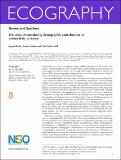The value of considering demographic contributions to connectivity : a review
Abstract
Connectivity is a central concept in ecology, wildlife management, and conservation science. Understanding the role of connectivity in determining species persistence is increasingly important in the face of escalating anthropogenic impacts on climate and habitat. These connectivity augmenting processes can severely impact species distributions and community and ecosystem functioning. One general definition of connectivity is that it is an emergent process arising from a set of spatial interdependencies between individuals or populations, and increasingly realistic representations of connectivity are being sought. Generally, connectivity consists of a structural component, relating to the distribution of suitable and unsuitable habitat, and a functional component, relating to movement behavior, yet the interaction of both components often better describes ecological processes. Additionally, although implied by ‘movement', demographic measures such as the occurrence or abundance of organisms are regularly overlooked when quantifying connectivity. Integrating such demographic contributions based on the knowledge of species distribution patterns is critical to understanding the dynamics of spatially structured populations. Demographically-informed connectivity draws from fundamental concepts in metapopulation ecology while maintaining important conceptual developments from landscape ecology, and the methodological development of spatially-explicit hierarchical statistical models that have the potential to overcome modeling and data challenges. Together, this offers a promising framework for developing ecologically realistic connectivity metrics. This review synthesizes existing approaches for quantifying connectivity and advocates for demographically-informed connectivity as a general framework for addressing current problems across ecological fields reliant on connectivity-driven processes such as population ecology, conservation biology and landscape ecology. Using supporting simulations to highlight the consequences of commonly made assumptions that overlook important demographic contributions, we show that even small amounts of demographic information can greatly improve model performance. Ultimately, we argue demographic measures are central to extending the concept of connectivity and resolves long-standing challenges associated with accurately quantifying the influence of connectivity on fundamental ecological processes.
Citation
Drake , J , Lambin , X & Sutherland , C 2022 , ' The value of considering demographic contributions to connectivity : a review ' , Ecography , vol. 2022 , no. 6 , e05552 . https://doi.org/10.1111/ecog.05552
Publication
Ecography
Status
Peer reviewed
ISSN
0906-7590Type
Journal item
Collections
Items in the St Andrews Research Repository are protected by copyright, with all rights reserved, unless otherwise indicated.

